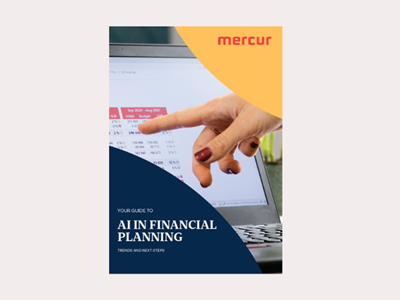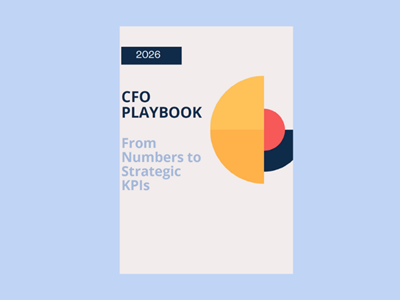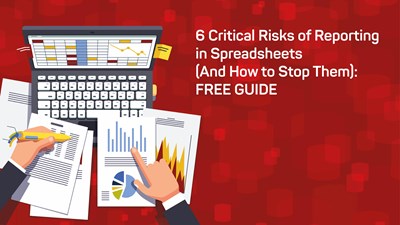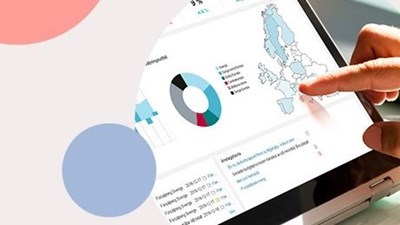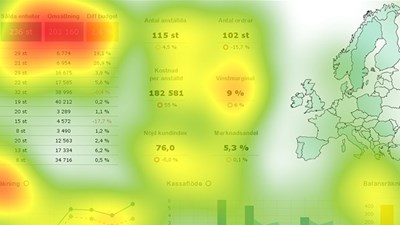.jpg?TS=638977552421057040)
Long-Range Planning: Connecting Strategy, Finance and Operations
The financial planning and analysis (FP&A) process has a major impact on the organisation's success. When making financial decisions, planning is crucial in achieving the business’s goals. A healthy cash flow can be maintained through long-term and short-term strategic solutions.
Long-range planning depends on building strong budgeting, forecasting and planning processes that align with future financial goals. Therefore, the secret to a successful LRP process is to use efficient FP&A software to plan, monitor and control long-term financial goals.
This article covers how to create a long-range plan, outlines its main components and explains how businesses develop strategies for long-term growth.
What Is Long-Range Planning?
A long-range plan (LRP) is a clear guide that helps organisations plan their finances over a 5- to 10-year period. The LRP process is not the same as the current forecasting or budgeting activities, which are planned for short periods.
Think of it as a roadmap that connects today’s activities to the future, bigger goals. Unlike short-term planning, where finance teams focus on the next year and mid-term strategies, long-term plans take a broader view of the finances, which takes time and resources to achieve these goals.
Creating an effective long-range plan takes insights from across the business. Leaders, teams and all departments play a crucial role in creating the vision of where the organisation is headed and how to get there.
The Importance of Long-Range Planning
There are many ups and downs in the market and the economy, making long-term planning a little overwhelming. Making predictions about what will happen next week can be challenging, so trying to plan one, two or even five years ahead may seem almost impossible. However, with careful and practical strategies, businesses can create effective long-term plans to maintain sustainable growth.
This means establishing clear goals and methods that will guide teams over the next five years and beyond. By following this plan, organisations can stay focused and better prepare their finances for future challenges.
LRP helps in:
Better use of resources.
Keep everyone focused on the organisation’s goals.
Encourages continuous improvements.
Supports stability.
Promotes smarter decisions.
Sustainable growth.
Still, a long-range plan is worth the effort. It helps map out not just the big-picture vision, but also the goals and actions needed to get there.
Key Components of Long-Range Planning
Before creating the plan, you should focus on several key points for a successful long-term plan, including:
Mission and Vision
What’s the company’s mission? What do you want to achieve when developing a long-term strategy? Together, mission and vision provide a clear direction for strategic planning. They help ensure that every goal and decision align with the organisation’s overall purpose by creating a clear guide that inspires teams to achieve these goals.
For example, when developing a 10-year plan, the finance team focuses on improving budget forecasting accuracy, optimising resource allocation and making other strategic investments, so that every action aligns with this goal.
SWOT Analysis
Another component in the LRP plan is performing a thorough SWOT analysis. Analysing your current strengths, weaknesses, opportunities and threats, as well as your competitors, can help your business prepare a more concise long-range plan. It is important to do in-depth both internal and external analysis, so you can improve your strategy based on your competitor’s weaknesses.
A common example of a SWOT analysis in finance is:
Strengths - your finance team has a strong financial forecasting model for better budgeting and resource allocation.
Weaknesses - teams focus on manual tasks rather than using automated financial forecasting software for accurate financial reporting, leading to mistakes.
Opportunities - implementing AI tools for advanced measurements into your long-term strategic plan.
Threats - market or economic changes may impact your planning, but the FP&A team should develop risk management strategies, like scenario planning, to act on time, before affecting the overall performance.
Identifying all these activities can help you achieve your financial goals and develop a more concise long-range plan.
Goal Setting
Clear goals between departments enable team members to stay focused, measure progress and ensure every action is towards the organisation’s long-term strategy. Operational plans include short-term targets and budgets that guide daily activities.
For example, the finance team might schedule quarterly reviews to track budget and adjust forecasts, while the sales team could set monthly sales targets and plan campaigns to achieve them.
How to Create an Effective Long-Term Plan
If you don’t know how to create a successful long-range plan, here are several main points to focus on:
Strategic Forecasting
Initially, you should start by analysing market trends and industry development so you can predict future outcomes. Understanding potential changes in demand, costs or competition, you can make better decisions to meet your long-term goals. This might include forecasting cash flow, investments return and revenue growth over the next five to ten years.
Resource Allocation
Next, ensure that financial, human and technological resources are effectively distributed. Proper planning helps to prevent bottlenecks or waste of resources. For example, an FP&A team may allocate the budget for software updates or staff training to support innovation.
Scenario Planning
Why is creating a scenario a crucial part of the financial planning process? Scenario planning ensures that the organisation can adapt to potential changes, including best or worst-case scenarios. This approach helps leaders make flexible strategies to adapt to various scenarios.
For example, a company might invest in additional resources for new opportunities to grow. In a worst-case scenario, similarly, the company might relocate resources if sales don’t perform as expected.
Prioritise Flexibility
Flexibility is very important for long-term success. Every plan should be flexible enough to adapt to changes in the market or technology. A rigid plan can become outdated, while an adaptable one allows organisations to respond to challenges and opportunities quickly, without damaging the overall performance.
If market conditions shift, for example, the leadership can adjust to a different budget or reallocate the resources without losing the initial long-term objectives.
Risk Management
A business may face various challenges and it must be prepared to handle them without disrupting performance. Risk management is a crucial part of the LRP process because, if planning ahead, organisations can identify and reduce risks that might harm the goals. By taking proactive steps, like continuously monitoring, you can successfully deal with any uncertainty. This can strengthen the company’s ability to maintain stability.
Mercur as an Effective Long-Range Planning Software
The right software should align with the business’s objectives. Compared to manual work, financial software has changed how an organisation handles complex and uncertain situations. Automated tools like Mercur combine forecasting, budgeting, scenario planning and financial reporting into one unified system. Without it, manual processes are slow, prone to mistakes and hard to update, which leads to missed opportunities. They also make teamwork and collaboration more difficult.
Therefore, Mercur stands out as a powerful tool for effective long-term planning. It helps businesses to connect strategy, finance and operations into a signal system that aligns their strategic objectives with financial planning.
Mercur facilitates Integrated Business Planning (IBP) through the Mercur Business Control® solution, which unifies departments such as sales, marketing, finance, supply chain and operations. This enables organisations to maximise profit and minimise risks. Also, Mercur's scenario planning capabilities provide organisations with a clear, practical way to test assumptions, spot risks and opportunities.
Conclusion
Long-range planning is important for any business that aims for long-term success. Growth doesn’t happen overnight. It comes from setting clear goals, a solid strategy and an action plan that every team will follow. With LRP, teams can focus on achieving these goals while being ready to respond effectively to market or technology changes. FP&A teams can strengthen the company’s stability by using the right software that allows shifting from complex spreadsheets to more accurate financial planning.
If you don’t understand the process, schedule a demo with Mercur and learn more about how to effectively create a long-range plan.
 Blog
BlogSave time and create a successful budget process
If you’re working in a large organization, you’re probably aware of how time-consuming the budget process can be. In this article we’ll give you tips on how to save time and still create a successful budget process
 Blog
BlogBusiness Budgeting Software: How to Choose the Right One
Choosing budgeting software is partly a finance and partly a strategic decision. The right tool helps organisations organise planning cycles, adapt as the market changes and increase accountability across departments. But not every platform will be a good fit.
 Blog
BlogAI and Machine Learning, what is it, and why is it important for the future?
Artificial Intelligence and Machine Learning, what is it, and what is the difference?
 Blog
BlogScenario Planning - Better control during uncertain times
Uncertain times create the need for more frequent forecasts and time for analyzing and comparing different future scenarios. We give you 5 tips on how to simulate future scenarios using scenario planning
 Blog
BlogHow to succeed with your planning, budgeting, and forecasting process
We know it can be challenging to succeed with your planning, budgeting, and forecasting process. Therefore, we have gathered our best tips for you to succeed!
 Blog
BlogHow can AI help CFOs make better decisions?
Artificial Intelligence (AI) has significant potential to enhance decision-making for Chief Financial Officers (CFOs) by providing data-driven insights, automating routine tasks, and enabling more accurate forecasts.
 Blog
BlogRisks with working in spreadsheets
Spreadsheets are an essential tool for all types of organisations and businesses rely on them heavily, particularly for financial computations. The most popular spreadsheet program globally is, of course, Microsoft Excel, it’s used by an estimated 750 million people.
 Blog
BlogBetter Revenue Planning
Sales forecasting is the process of predicting future revenue based on past data and trends. Read the blog to learn the best methods to do it right.
 Blog
BlogAI in Financial Planning: Trends and Next Steps
Discover how finance teams are using AI to drive smarter planning, faster insights, and stronger business decisions.
 Blog
BlogHow EPM Transforms Financial Planning and Forecasting
Struggling to keep plans aligned in a changing market? Discover how EPM helps finance teams move faster, stay accurate and lead with real-time insights.
 Blog
BlogHow do finance teams track KPIs across the entire organisation?
Learn how finance teams track KPIs across the entire organisation by consolidating data from multiple sources into a unified system like Mercur.
 Blog
BlogVariance Analysis: A Comprehensive Guide
Senior executives are demanding more detail in their management reports. The amount of data available to finance departments has exploded and decision makers see this as an opportunity to get more insight into how the business is performing.
 Blog
BlogBalancing Profitability and Sustainability
Sustainability has become a central concern for organisations across the world — and the UK is no exception. This evolving landscape places new demands on financial reporting.
 Blog
BlogManagement Reporting Guide: Definition and Tips
Management reporting helps you see what’s really happening in your business. In this guide, we’ll explain what managerial reporting looks like and share practical tips.
 Blog
BlogSpreadsheets are not Collaborative Tools
Spreadsheets were never designed for collaboration, yet they are the single most used program among teams and co-workers. They often start out as a quick document for storing, formatting or calculating information but evolve into important documents and are often the core records for an organisation.
 Blog
BlogWhy is our Excel-based budget always out of date?
Excel creates outdated budgets. Every time someone enters a figure, sends a file, or waits for another department to finish their section, your budget falls further behind reality.
 Blog
Blog3‑Statement Model for Better Financial Forecasting
Financial forecasting is critical for any business that wants to adapt to change. But finance teams keep usingfragmented models and manual processes. The 3-statement financial model is the solution.
 Blog
BlogHow to Effectively Budget with Driver-Based Forecasting
Traditional models of forecasting rely on historical data and beliefs. It uses techniques that identify patterns, which are simple to use. However, with these methods, there are some challenges because they are not dynamic with today’s market, and can’t effectively analyse complex data.
 Blog
BlogFrom static budgets to agile financial management
Traditional budgeting has long been the cornerstone of financial planning in businesses. But today it can become more of a limitation than a strength. That’s where the concept of Beyond Budgeting comes in.
 Blog
BlogAI in corporate budgeting
Artificial Intelligence (AI) can support decision making in key areas such as budgeting, capital allocation and even corporate strategy and as a result, it is increasingly being deployed in corporate performance management tools (CPM).
 Blog
BlogHow Automated Reporting Will Transform FP&A in 2026
This article highlights the power of report automation, how to implement it in your business and explores any new opportunities for accurate financial analysis in the long run.
 Blog
BlogBest Guide to Improve Your Revenue with Flexible Budgeting
Optimise your expenses with flexible budgeting, and learn how to adjust budget to reflect current business activities, market changes and cost fluctuations.
 Blog
BlogWhat Is Planning, Budgeting and Forecasting?
Planning, budgeting and forecasting are rarely static. Shifts in the industry often require you to revisit assumptions, adjust targets and adopt new processes. Learn how to strengthen your approach and stay ahead of change.
 Blog
BlogCFO Playbook - KPIs for 2026
The role of the CFO is changing fast. Today, the finance function is expected to deliver more than reports — it must drive direction, speed and profitability through clear, actionable KPIs. Learn more in this guide.
 Blog
BlogThe Powerhouse of EPM Tools
A business’s success heavily relies on having a strong strategy. However, what's even more important is implementing that strategy while tracking and measuring the performance. This can easily be done by investing in enterprise performance management (EPM) software.
 Blog
BlogMastering Spreadsheets
Where many businesses start small, a simple spreadsheet can adequately perform the limited tasks required of it. As the company grows, your spreadsheets can get more complex and harder to manage, by which point it feels like it will be too difficult to move to a different reporting tool.
 Blog
BlogTop-Down vs Bottom-Up Budgeting
Budgeting aligns resources with strategic goals, and there are two primary approaches: top-down and bottom-up. Which method wroks best?
 Blog
BlogSpreadsheets Risk the Future of the Business
Spreadsheets often start as just a list for storing information and there is minimal process documentation, support or maintenance for these worksheets. Despite the fact that desktop applications such as Microsoft Office are included in the standard configuration of users' PCs, very little formal training is ever given to spreadsheet users.
 Blog
BlogFP&A Trends Shaping Financial Planning in 2025
Many organisations cope with fragmented planning and data quality issues, which slow down their forecasting cycles. This forces organisations to take practical steps to turn ambition into execution.
 Blog
BlogTop PowerBI Alternatives in 2025
Explore the top PowerBI alternatives for 2025. Discover how Mercur delivers integrated planning, budgeting and reporting without the high cost and complexity.
 Blog
BlogCash Flow Forecasting
Inaccurate cash flow forecasting can be a costly mistake for companies. In today’s volatile market, relying on static annual budgets or manual spreadsheets leaves financial leaders without the agility to respond to uncertainty.
 Blog
BlogThe Role of the CFO: Top Priorities and Responsibilities
Today's finance leaders steer more than just budgets and reports. The digital transformation ramps up with the increase of corporate complexity, and so does the role of CFOs.
 Blog
BlogSpreadsheet Risk Management: Best Practices for 2025
Excel has long been a target for hackers; just one click on a malicious attachment can infect your entire network. So, how can you keep using spreadsheets while not sacrificing your safety?
 Blog
BlogRolling Forecasts: Practical Steps, Benefits, and How to Get Started
Financial planning has changed. Traditional annual budgets can’t keep up with rapid shifts in the market, evolving customer needs, and internal performance dynamics. That’s why many finance teams are turning to a rolling forecast model.
 Blog
BlogThe Collaborative, Smarter Budget
In many organisations manual budgeting processes over-burden staff and create masses of data which overwhelms department heads and stops them seeing the bigger picture.
 Blog
BlogInformed Business Decisions at Maximum Velocity
The ability to process information swiftly is essential. If your business can’t manage your data efficiently, your company’s financial performance will surely underperform. At Mercur we have developed our own database Veloxic which helps Financial Planning and Analysis.
 Blog
BlogAI in Finance as a Powerful Tool
In this post, we explore how AI is evolving from a theoretical concept into a valuable resource for decision-making. Get useful insights for finance teams at any stage, from early exploration to actively using AI-powered solutions.
 Blog
BlogHow To Create a Successful Budgeting Process
When done well, budgeting helps organisations stay financially on course, even when things don’t go exactly as planned. Learn how to keep things on track so you avoid surprises and stay focused on your goals.
 Blog
BlogA practcial guide to scenario planning
Scenario planning gives you a clear, practical way to test assumptions, spot risks and opportunities, and make better strategic choices so your organisation stays resilient when conditions change.
 Blog
BlogHow to get accurate financial reports without waiting for month-end
You don't need to wait until month-end to see accurate financial reports. With modern financial systems you can access up-to-date reports whenever you need them.
 Blog
BlogWhat is Corporate Performance Management? (CPM)
CPM, or Corporate Performance Management, is a process within corporate management aimed at measuring and optimizing the performance of an organization. CPM encompasses a range of activities, including budgeting, planning, forecasting, reporting, and analysis.
 Blog
BlogFive tips for a successful budget process!
How can you make your budget process more successful and maximise the effort that was invested in creating it? Of course, there are many factors to consider but we’ve chosen to highlight five key areas that will enable and help you create a smoother, value-creating and collaborative budget process.
 Blog
BlogTop 7 Manager KPIs for Financial and Operational Success
In today's post we'll break down why KPIs matter, which ones offer the most insight for finance and executive teams and how to ensure they're actually driving results.
 Blog
BlogThe Hidden Cost of Data Silos
If you ever feel like your teams speak different languages when it comes to data, it is a classic symptom of data silos. The information gets stuck in one department, system or tool, making it difficult for anyone to see the full picture.
 Blog
BlogWhat Is FP&A? Definition, Purpose, and Best Practices
Without solid financial planning and analysis (FP&A), businesses operate in the dark. In this post we go deeper into the process of FP&A and why it’s important for businesses.
 Blog
BlogZero-Based vs. Incremental Budgeting
Budgeting sits at the heart of sound financial management. This is why choosing the right technique is crucial for CFOs – it shapes resource allocation, cost control and strategic agility. Incremental and zero-based budgeting are two leading methods that offer distinct approaches.
 Blog
BlogWhy xP&A is a powerful game-changer
The newest iteration of planning, analysis and reporting systems is a powerful game-changer that unites company departments and boosts competitiveness. It’s called xP&A – the abbreviation of extended financial planning and analysis.
 Blog
BlogBudgeting in a modern world
Thirty years after its debut, Microsoft Excel is still the preferred tool for budgeting and planning projects. However, its popularity is declining, due in most part to the rise of technology and subscription-based pricing for a myriad of SaaS-based products.
 Blog
BlogThe Business Benefits of Integrated Business Planning
This blog explores what IBP is and the typical IBP process. We highlight business benefits and how the right software can be a game-changer for your organisation.
 Blog
BlogWhat is management reporting?
Management Reporting refers to the process of creating, analyzing, and presenting information about various aspects of an organization's performance to enable decision-makers to make well-informed decisions about the future.
 Blog
BlogBusiness Intelligence Reporting For Finance Teams
The real challenge today isn’t collecting data, it’s making sense of it and fast. Organisations turn to business intelligence (BI) to convert raw data into insight.But how do you actually do it right?
 Blog
BlogBoost Report Readability, Engagement, and Decision-Making
In today’s fast-paced business environment, effective reports and dashboards are crucial for decision-making. Our user study using eye-tracking technology revealed seven key insights into what captures attention.









